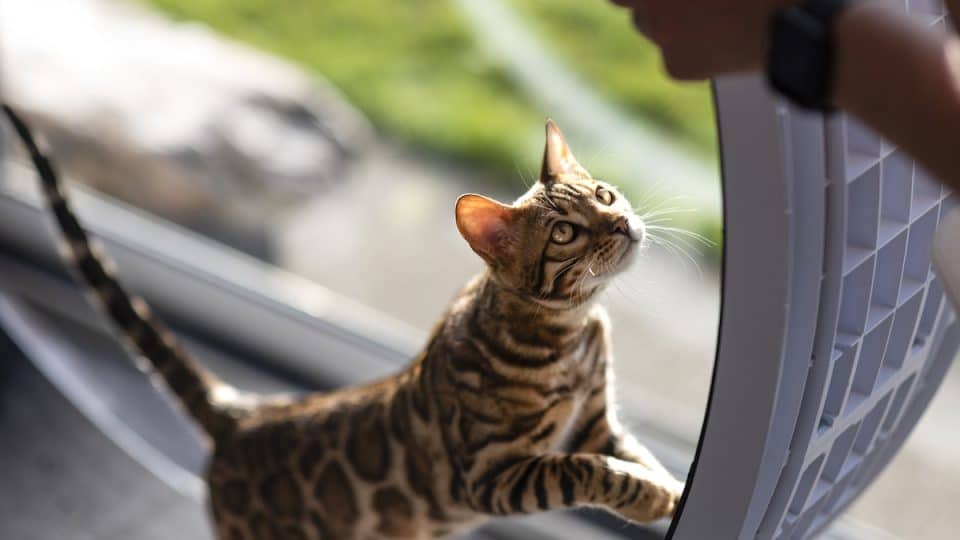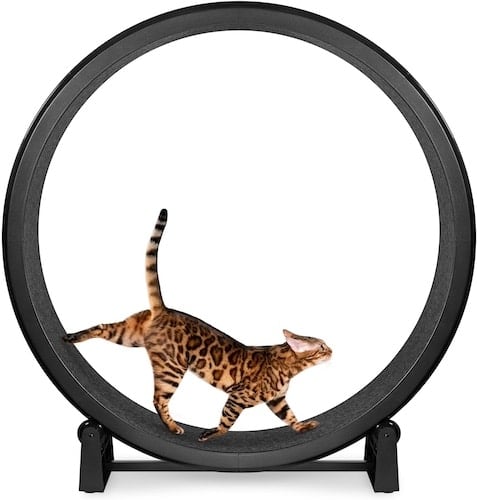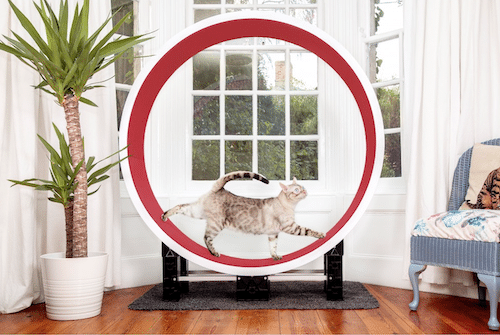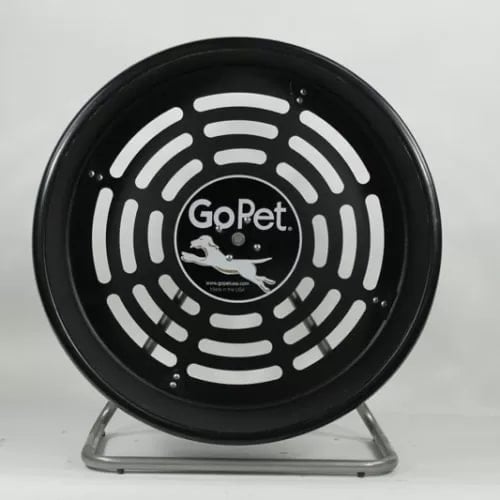- This post contains affiliate links. Read more here.
- Not a substitute for professional veterinary help.
Regular exercise is essential for a cat’s physical and mental health, especially indoor kitties. While interactive play activates your cat’s natural instincts and helps them burn off excess energy, daily sessions with a laser pointer or wand toy might not be enough for highly active cats.
That’s where a cat exercise wheel can help, providing self-appointed entertainment and exercise for bored and hyperactive kitties. However, not all cat wheels are created equal, and not all cats will use them. So, are they even worth trying?
To learn more about cat exercise wheels, including which ones are the best and how to know if your cat will even use one, we spoke with cat experts, from vets to behaviorists.
How Different Are Cat Wheels?
Cat exercise wheels have been around for two decades, with early models hailing from the UK and elsewhere in Europe—many of which originated as DIY cat exercise wheels in garages and workshops. These days, cat treadmill wheels are commercially available and typically share the same rotating track concept. However, they differ in a few key ways:
- Materials. Cat wheels can be made out of plastic, wood, or compostable materials.
- Wheel size. Wheel diameters come in various sizes. As Dr. Bethany Hsia, veterinarian and co-founder of CodaPet, explains, a cat wheel should be “large enough for your cat to comfortably run without feeling cramped or restricted” and wide enough that your cat can turn around without jumping off.
- Traction. The wheel’s interior is typically lined with some type of grippy texture, like sisal, rubber, or low-pile carpeting.
- Mounted vs. freestanding. Some wheels are freestanding (like all three of our picks below), while others can be wall-mounted to save space.
- Noise levels. Cat running wheels are bound to create some noise. Still, some models are louder than others.
Cat wheels tend to come and go on the market, but two larger-sized models have proven to have staying power. These are the One Fast Cat Exercise Wheel and The Ferris Cat Wheel. Though they each have a few limitations, we’ve found them to be of better quality than many of the other cat wheels out there. For homes with limited space, GoPet has also been gaining traction (pun intended) in the cat wheel world. Let’s take a detailed look at all three.
Best Overall: One Fast Cat Exercise Wheel (Verified Review)
The One Fast Cat Exercise Wheel measures 48 by 47 inches and has a wheel width of 10.75 inches, a suitable size for a wide range of cats. The inside wheel is lined with durable EVA foam and felt traction pads to prevent claws from catching when running. The base is also set with four spinning rollerblade wheels to power your cat’s movement.
- Assembly: Arrives in a heavy but relatively modest-sized box. Our One Fast Cat testers thought it was tricky to assemble but found customer support to be helpful. Instructional videos are also available on the company website.
- Ease of use: Some pet parents report that teaching their cat to use the wheel only took one training session. Others needed multiple sessions and more positive reinforcement (like alluring toys or treats).
- Good for: High-energy cat breeds and curious cats.
- Reconsider if: You have young kittens or seniors, or skittish or low-energy cats.
Best for Large Cats: The Ferris Cat Wheel (Verified Review)
This wheel measures 56 inches high and 51 inches wide with a 48-inch inner diameter, making it a choice pick for larger cats. (We even know a 16-pound Mini Dachshund who happily runs on it for treats.) The inner trackpad has a generous width of 12.5 inches and includes thick, stick-on EVA foam tiles. Made of ABS plastic and reinforced with bolt assembly, the sturdy wheel features six skate wheels within the base’s legs.
- Assembly: Our testers appreciated that the Ferris Cat Wheel’s assembly—though a little time-consuming—was significantly less confusing than other models. The wheel comes with a robust set of tools and spare pieces to make sure you have what you need.
- Ease of use: Many reviewers say the wheel is easy to use, stable, and provides a smooth operation. Our Rover reviewers loved that once up and running, the wheel glides effortlessly, requiring just a little cat power to go a long way.
- Good for: Larger-sized or multiple cats.
- Reconsider if: You have smaller cats or limited household space.
Best for Smaller Spaces: GoPet Cat Treadwheel
Though the GoPet Cat Treadwheel is quite pricey (at nearly $800), it’s also the smallest and quietest exercise wheel on our list. It’s a standard 12 inches wide, but it measures only 44″ by 41″ inches, making it significantly smaller than either of our other picks. It’s also free of ball bearings, which can be quite noisy. Both features are ideal for pet parents in apartments, condos, or other homes with limited space.
- Assembly: Ready to use right out of the box. No assembly is required.
- Ease of use: The tough rubber traction pad helps provide grip, and the running center shaft provides smooth spinning for all types of cats.
- Good for: Kittens, adult cats, and smaller living spaces.
- Reconsider if: You have larger cats or a limited budget.
Pros & Cons of Cat Wheels
So, if you buy a cat exercise wheel for your kitty, will they really use it? Maybe! But also, maybe not. “Most cats with the confidence and curiosity traits will use a wheel, but generally speaking, I would say the chances are 50/50,” says Mieshelle Nagelschneider, certified cat behaviorist and owner of The Cat Behavior Clinic.
Patrik Holmboe, head veterinarian for Cooper Pet Care, also thinks it’s a bit of a gamble. “It’s hard to estimate a percentage of cats that can be trained to use an exercise wheel, as it depends on various factors like the cat’s temperament, age, breed, and overall health condition. If you have a cat that likes to run and is somewhat easy to train, it might be an option for you,” he says.
To figure out if a cat running wheel is worth trying, we weigh the pros and cons below.
Pros of cat exercise wheels
- Encourages weight loss. “Should a cat like and use an exercise wheel, they do provide numerous benefits,” Holmboe says. “They can help to improve their overall health and well-being, including weight management. Just like in humans, generally, the more exercise an individual gets, the healthier it is!”
- Offers outlet for high-drive cats. A cat exercise wheel can provide entertainment for high-energy breeds, such as Bengals, Siamese, and Maine Coons, and cats with a high play drive (i.e., the ankle sneak-attack cats).
- Provides novelty and mental stimulation. Curious and adventurous cats who like to try new things might benefit from having a cat wheel in their home. It can also offer mental stimulation, helping reduce boredom and prevent destructive behaviors.
- Offers more room to exercise. Cat wheels give cats more room to run indoors, especially in homes with limited space. “They provide an outlet for cats to burn off excess energy and keep them physically and mentally active,” says Holmboe.
Cons of Cat Exercise Wheels
- Training can be tricky. Not all cats will take to training (see tips below). Ultimately, it will depend on your cat’s preferences and personal motivation.
- Good cat wheels are typically pricey. As seen in our picks above, a cat wheel that’s well-constructed with quality materials can be quite an expensive investment, especially if your cat doesn’t end up using it.
- Sizing issues. If a cat wheel is too small, a cat may have to contort their body while running to fit, which could ultimately hurt their spine. However, not all pet parents have enough room for a large cat wheel in their homes.
- Requires close monitoring. “It’s always recommended to observe your cat’s behavior and consult with a veterinarian before introducing an exercise wheel to ensure it’s safe and appropriate for your cat,” says Holmboe.
How To Train a Cat To Use a Cat Wheel
You can train your cat to use a cat wheel using several methods, such as:
- Social learning. “Cats can learn by watching another cat use the wheel,” notes Nagelschneider. So, if you have a friend whose kitty is a pro on the wheel, he may be able to show your cat some pointers.
- Wand toy. “I recommend using the cat’s favorite wand toy out in front of the cat and above its line of sight against the wheel,” says Nagelschneider. “The cat will attempt to catch the feather by moving forward and simultaneously walking (or running) on the wheel to catch the toy.”
- Catnip. “If your cat responds to catnip, it’s a wonderful behavior tool to help activate playful and confident behavior,” notes Nagelschneider. She adds that you can even use a teaser wand and catnip together if your cat prefers.
- Treats. Similar to a wand toy, hold a tasty treat in front of your cat to encourage them to walk on the wheel. Mark and reward your kitty every time they take a step on the wheel.
Nagelschneider advises against giving up too soon. She recommends placing the wheel in a quiet space without too many distractions. You’ll also want to train when your cat has the most energy and brain power, avoiding training sessions when your cat usually takes naps.
What Cats Won’t Use a Wheel?
While there’s no way to 100% know if your cat is going to use an exercise wheel, there will likely be signs. “Generally speaking, a more confident cat versus a skittish cat is much more likely to use a wheel,” says Nagelschneider. “Stepping onto the wheel and suddenly having it move can be frightening for a more timid cat.”
Other cats that may not take to a cat running wheel include the following:
- Young kittens, senior cats, and kitties with mobility issues
- Brachycephalic/short-nosed breeds who have trouble breathing during high-intensity exercise
- More sedentary cats who rarely show interest in physical activity
Alternative forms of enrichment
Don’t fret if your cat doesn’t take to a cat exercise wheel. There are a ton of other ways to keep your cat active, including:
- Cat puzzles
- Interactive toys like lasers or wands
- Lick mats
- Cat climbing trees or shelves
- Clicker training
Just like you have certain ways you like to move your body, your cat will also have his own preferences. Think of it like a treadmill. Some people enjoy using them at home, and others prefer different physical activities. It’s up to you to figure out what your cat likes to make them both happy and healthy!






